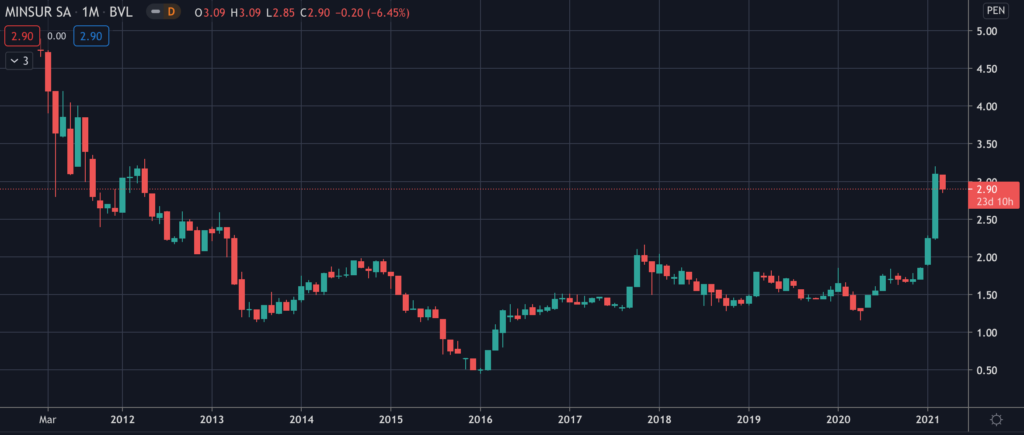Common Stock: Minsur (MINSURI1)
Current Market Price: $0.80 USD ($2.90 PEN)
Market Capitalization: $790 million USD ($2.8 billion PEN)
**Note: All values in this article are expressed in United States Dollars (USD) unless otherwise noted.

Minsur Stock – Summary of the Company
Minsur is a mining company focused on the acquisition, exploration, development, and operation of precious and base metals properties. They are mainly focused on properties in Peru, where they own 2 producing mines as well as a tin smelter. Their San Rafael mine is one of the largest tin mines in the world, producing around 12% of the worlds tin annually. In addition to their Peruvian operations, they own one operating mine and a smelting unit in Brazil. Minsur was founded in 1977 and is headquartered in Lima, Peru.
Revenue and Cost Analysis
Minsur had revenue of $649.2 million in 2020, a decrease from $711.5 million in 2019. Their COGS was $412.6 million in 2020, representing a gross margin of 36.4%, on par with their gross margin of 37.3% in 2019.
In 2020 Minsur had a net loss of $2.3 million. This represents a significant deterioration from net income of $62.8 million in 2019.

Balance Sheet Analysis
Minsur has a decent balance sheet. They have a sound base of long term assets and sufficient liquidity in the near term. The company is slightly leveraged, with relevant amounts of long term debt outstanding.
Minsur – Debt Analysis
As of year-end 2020 the company has $1.4 billion in total debt outstanding, $151 million of which is classified as current.
Minsur Stock – Share Dynamics and Capital Structure
As of year-end 2020 the company has 19.2 million preferred shares outstanding and 961 million common shares outstanding. The company has two shareholders with an ownership position larger than 10%.
Minsur Stock – Dividends
The company paid a dividend of $0.02 cents per common share in 2020. At the current market price this implies a dividend yield of 2.8%.
Minsur Stock – 3 Metrics to Consider
Debt to Equity Ratio
Total Liabilities/Total Share Holder Equity
$2.1 billion / $1.7 billion = 1.2
A debt to equity ratio of 1.2 indicates that Minsur uses a mix of debt and equity in its capital structure, but is slightly leveraged, and relies more on debt financing for funding.
Working Capital Ratio
Current Assets/Current Liabilities
$632.3 million / $504 million = 1.3
A working capital ratio of 1.3 indicates a sufficient liquidity position. Minsur should not have problems meeting its near term obligations.
Price to Book Ratio
Current Share Price/Book Value per Share.
$0.80 / $1.71 = .47
Based on total shares outstanding Minsur has a book value per share of $1.71. At the current market price this implies a price to book ratio of .47, meaning Minsur stock currently trades at a significant discount to the book value of the company.
Minsur Stock – Summary and Conclusions
Minsur is an impressive company. They are one of the largest tin miners in the world with a diversified production portfolio of several operating mines and a smelting business. The company is in decent financial health, with sufficient liquidity and reasonable liability levels, although they are slightly leveraged.
I do not know enough about the tin market, so I will not invest in Minsur stock. I am very intrigued by the company’s global scale relative to its financial position. I am going to further research the tin market and revisit Minsur stock once I am more informed.
Investors can compare Minsur stock to the zinc mining company Nexa Resources.
Disclaimer
This is not investment advice. Nothing in this analysis should be construed as a recommendation to buy, sell, or otherwise take action related to the security discussed. If I own a position in the security discussed, I will clearly state it.
This is not intended to be a comprehensive analysis and you should not make an investment decision based solely on the information in this analysis. I hope this serves as a useful starting point for a more comprehensive analysis, and hopefully draws attention to aspects of the company that were overlooked or merit further investigation. This is by no means intended to be a complete analysis. Again, this is not investment advice, do your own research.